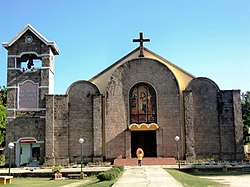San Narciso | |
|---|---|
| Municipality of San Narciso | |
 San Narciso Church | |
 Map of Quezon with San Narciso highlighted | |
Location within the Philippines | |
| Coordinates: 13°34′04″N122°34′00″E / 13.5677°N 122.5667°E | |
| Country | Philippines |
| Region | Calabarzon |
| Province | Quezon |
| District | 3rd district |
| Founded | February 2, 1846 |
| Named after | Narcissus of Jerusalem |
| Barangays | 24 (see Barangays) |
| Government | |
| • Type | Sangguniang Bayan |
| • Mayor | Florabelle U. Uy-Yap |
| • Vice Mayor | Elena R. Babao |
| • Representative | Reynante U. Arrogancia |
| • Municipal Council | Members |
| • Electorate | 33,152 voters (2025) |
| Area | |
• Total | 263.58 km2 (101.77 sq mi) |
| Elevation | 51 m (167 ft) |
| Highest elevation | 305 m (1,001 ft) |
| Lowest elevation | 0 m (0 ft) |
| Population (2024 census) | |
• Total | 53,375 |
| • Density | 202.50/km2 (524.47/sq mi) |
| • Households | 12,199 |
| Demonym | San Narcisohin |
| Economy | |
| • Income class | 3rd municipal income class |
| • Poverty incidence | 19.81 |
| • Revenue | ₱ 266.6 million (2022) |
| • Assets | ₱ 779.9 million (2022) |
| • Expenditure | ₱ 159 million (2022) |
| • Liabilities | ₱ 69.52 million (2022) |
| Service provider | |
| • Electricity | Quezon 1 Electric Cooperative (QUEZELCO 1) |
| Time zone | UTC+8 (PST) |
| ZIP code | 4313 |
| PSGC | |
| IDD : area code | +63 (0)42 |
| Native languages | Tagalog |
| Website | www |
San Narciso, officially the Municipality of San Narciso (Tagalog : Bayan ng San Narciso), is a 1st class municipality in the province of Quezon, Philippines. According to the 2020 census, it has a population of 51,058 people.


